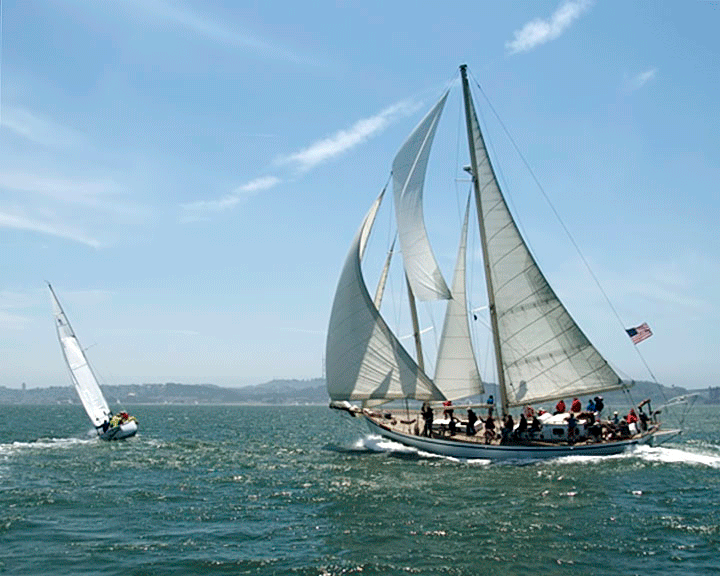
 |
| EDUCATION | CATALOG | RIGGING | CONSULTATION | HOME | CONTACT US |
|
#1
|
|||
|
|||
|
As some know, my Lapworth-36 Papoose was dismasted this spring. I am still waiting for the new aluminum mast (keel stepped). I have made measurements on the boat and find the following. I am using the upper chainplate-deck intersection as the reference. The center of the mast step is 7/16 off center to starboard. The opening in the cabin top where the partners and mast collar are is 1 inch off center also to starboard. (Yes it really is. Easy to see just by looking at the boat.) The opening is rectangular in shape. The old mast came up from the mast step and excited through the center of the partners and then went straight up so it was 1 inch to starboard at the top. In other words, it had a little dog leg in it, just 1/2 inch. Clearly not OK with the new mast.
What I am considering is keeping the bottom of the mast centered on the mast step and centering the top between the chainplates. This will mean the mast is not straight but rather tilting 0.05 degrees (approximately nothing). The mast would clear the existing collar by 0.4 inches on the port side. I considered just leaving everything like this and using Spartight. That was vetoed by my shipwright. He wants to route out the cabin top and fill in the opening and make it fit the new mast, which is more oval than rectangular. I contacted Garhauer about making a new collar and the discussion ended with the possibility of making a new collar and deck plate that is large enough to cover the existing opening with a 1/4 inch steel, The collar would be 2 inches high about 1/2 inch spaced from the mast. This would be bolted to the cabin top so that filling in the existing hole would not be necessary. The cabin top is 6 layers of 1/4 inch plywood. The other alternative is to do what my shipwright suggested plus make a new mast collar. This would allow the wedges to act directly against the cabin top as well as the collar. I kind of like the idea of the new heavy plate and collar with the larger opening in the cabin top so that things could be adjusted after the new mast was set in case my measurements are off. But I am not sure it is OK to have the load to to the collar, through the base, and then to the bolts in the cabin top rather than directly to the cabin top. Looking for some advice. PS. I had a protest hearing and the boat that hit me was found to have broken rules 11, 12, and 14. I broke no rule. I settled with their insurance company and got what I wanted. Less than what it would take for a wood mast, but I didn't want a wood mast as the boat I race against has done well with his aluminum rig.  Allen L-36.com Last edited by allene : 10-14-2016 at 05:22 PM. |
|
#2
|
|||
|
|||
|
Hello,
Either the shipwright or the Garhauer option would be better than leaving things as they are; your boat will notice the difference. While taking the load to the house top via the throughbolts would not be quite as good as direct contact, bushings around the bolts, to distribute the shear load to more wood fibers, would fix that. Bushings would simultaneously prevent the wood from being crushed by the nuts and bolt heads. The shipwright's version would be the cleanest, and allow the most options for mast shape and rake. Either option is compatible with Spartite. Fair leads, Brion Toss |
|
#3
|
|||
|
|||
|
On the Garhauer approach, what if I hold it down with a 1/4 inch bolt every 1.5 inches. That would be 26 bolts and 6.5 inches of linear surface compared to 8 inches for the mast partners. If that wasn't enough, I could use 5/16 bolts and get 8 inches. Seems like bigger bolts would do the same thing as spacers although it would be threads in one case and a smooth surface in the other unless the bolts had a significant unthreaded section like a carriage bolt.
|
|
#4
|
|||
|
|||
|
Hi again,
That kind of spacing would be a net loss; too much material removed. Wood is strongest in compression, and that is what the bolts will be applying, as the mast tries to move them sideways. Bushings are your friend here, providing surface area. Another way to look at it is that the mast doesn't need all that partner surface area; there is just no way to have any less. I think that as few as 6 bolts, properly bushed, would be fine. Fair leads, Brion Toss |
|
#5
|
|||
|
|||
|
What size, kind of bushing? Not fully understanding yet. I need way more than 6 bolts to hold the plate down so are you suggesting bushings on only some?
Allen |
|
#6
|
|||
|
|||
|
Hi again,
The primary load on those bolts will be in shear. Even if the deck plate doubles to support halyard turning blocks, it is most unlikely that any halyard would provide even a 1,500lb vertical pull; tensile strength of a 5/16" bolt is about 8,000lbs. 1/4" wall bushings would be fine, and on all the fasteners. Thicker is better. Fair leads, Brion Toss |
 |
| Thread Tools | |
| Display Modes | |
|
|